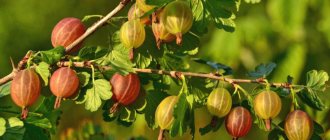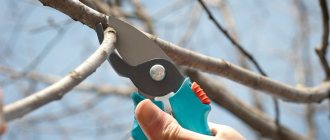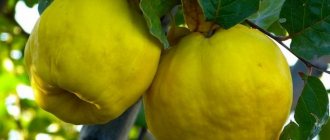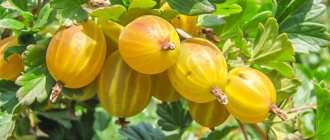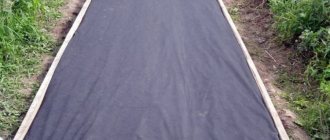After the first frost, the berries on remontant raspberries stop ripening, which means it’s time for pruning. If you live in the middle zone and further north, then in October-November you need to completely cut off the stems and fill the raspberry garden with organic matter - the harvest next year will be excellent.
When it comes to remontant varieties, caring for raspberries in the fall causes difficulties for many gardeners. This plant is truly unusual. Particularly surprising is the autumn pruning, after which the plantation turns into a plot of bare earth. But if you need remontant raspberries to show their merits, you cannot do without this radical measure.
Planting raspberries in autumn
If you don’t already have remontant raspberries, fall is the time to plant them. Don't wait until spring. Autumn seedlings take root well and produce a harvest next year.
How to plant raspberries in the fall:
- Dig holes at a distance of 70 cm from each other or a trench as deep as a spade bayonet.
- Pour a little superphosphate and humus onto the bottom and mix well with the soil.
- Release the seedlings from the packaging and plant with the root collar deepened by 3-5 cm.
- If the seedlings arrived uncut, then leave the shoots 20 cm high.
- Water well (each plant will need 2 buckets of water.
- Sprinkle the soil that has settled after watering with dry soil.
Attention. After the first frost, bushes planted in autumn should be sprinkled with fallen leaves.
Caring for raspberries starting in spring
In order for the raspberry tree to be free from pests and produce a large harvest, it must be well looked after, starting in spring. Already in April it should be sprayed with Bordeaux mixture, following the recommendations in the instructions. In summer, during flowering, you can treat them with biological products against pests.
As soon as you notice that the bushes are pale green and weak, immediately add humus (5-6 kg per 1 sq.m.). Fertilizing with a solution of chicken manure (1:20) or mullein (1:10) works well at the rate of 3-5 liters of ready-made fertilizer per 1 sq.m of planting.
Apply complex fertilizers in March-April. Do not forget to apply phosphorus-potassium fertilizers in the spring and during flowering (50-80 g of superphosphate and 40 g of potassium sulfate per 1 square meter).
Below are some summer tips for beginners:
- If you haven’t purchased fertilizer, then collect a bucket of weeds, fill it with water, and let it sit for a week.
- Then dilute at the rate of: 1 liter of infused liquid per bucket of water, spray the bushes, repeat spraying after a week.
- Feed the plants at the roots with the same liquid once a week.
How to prune raspberries in autumn
Varieties that produce one harvest per year are classified as ordinary. Their berries form on last year's overwintered shoots - this feature must be taken into account when pruning. These raspberries need to be pruned at the end of summer, as soon as the shoots bear fruit. Those who have hesitated will have to do this work now:
- Use pruning shears to cut off the shoots from which the berries were collected this year at the root - they differ from young ones in their darker color and flaky bark.
- Thin out the young growth. But don’t overdo it, leave a reserve in case it freezes. It is considered sufficient if 7-10 young shoots remain per linear meter of raspberry bush in the fall.
Features of remontant species
The name comes from the French word, translated meaning “bearing fruit repeatedly.”
Remontant varieties are capable of bearing berries not only from last year’s two-year-old shoots, but also from new, one-year-old shoots, i.e. twice per season - in summer and autumn.
If summer raspberry bushes can be pruned after picking the berries, then there is no need to rush into pruning these varieties. The timing of their preparation for winter is noticeably delayed, because... It will still be possible to harvest the autumn harvest from the new shoots.
How to prune remontant raspberries
Remontant varieties bear fruit twice a year: in the summer at the same time as the usual ones and in the fall - until frost. They produce more berries, so they require increased nutrition, generous watering and plenty of sun. The technique for pruning remontant raspberries in the fall depends on what climate zone you live in and how many harvests you plan to get.
Pruning remontant raspberries in warm regions for 2 fruitings:
- Find old branches and cut them at the root.
- Leave on each bush 4-5 young strong shoots that bear fruit in the fall, cut everything else to the ground level, and cut out the root shoots with a shovel.
In the middle zone, new growth that bears fruit in the fall will not have time to become lignified and will not overwinter. Therefore, it is more rational to grow remontant raspberries with one autumn fruiting. In this case, all shoots must be cut at the root before wintering.
After pruning, the raspberry tree should remain empty. Don’t worry about its safety – there are living buds in the ground. In the spring they will begin to grow, over the summer strong shoots will form and by autumn they will bear fruit. This harvest will be very bountiful. It is precisely because of the opportunity to get a lot of berries in the off-season when experienced gardeners answer the question of whether to prune raspberries in the fall in the affirmative.
Watering raspberry bushes
In summer, remontant raspberries need abundant watering. If there is no extreme heat, and it rains only occasionally, then watering is carried out once a week - 2 buckets per 1 square meter. meter. During flowering and ripening of berries, this type of raspberry especially needs watering to a depth of 30-40 cm. This is the only way the roots will be able to extract nutrients from the soil.
To prevent the soil under the bushes from drying out, it must be covered with mulch. Mulch will make caring for plants easier: weeds will not grow, and you won’t have to water and loosen frequently. As mulch, you can choose peat, sawdust, humus, mown grass, or cover it with black spunbond.
If you cannot do without loosening, then you need to loosen it very carefully, because the roots of this plant are located close to the surface. The first loosening is carried out before the buds open, and the subsequent ones, when you see that weeds have appeared or the soil has dried out very much.
The last loosening of the soil is carried out after the real cold snap. This loosening is important for the destruction of pests overwintering in the soil.
Autumn feeding
After pruning, it is useful to feed the berry plant. Raspberries love organics. Fill the rows with humus in a layer of about 5 cm.
Important. Sometimes gardeners mix manure with ash to apply two fertilizers at once. This cannot be done - ash and humus neutralize each other’s beneficial properties. It is better to add organic matter in the fall and ash in the spring.
Fertilizing raspberries for winter
As the fruiting season continues, gardeners usually apply good fertilizers several times, which should contain potassium, nitrogen and phosphorus.
When the autumn season arrives, it is important to fertilize raspberries with phosphorus and potassium fertilizers. The fact is that such an event will have a positive effect on increasing immunity and the plant’s resistance to frost.
Frost protection
Raspberries are not covered in all regions, but only in cold ones and with little snow. If the variety is new and you are not sure of its winter hardiness, tie the stems into a bunch and bend them to the ground.
In areas where there is a lot of precipitation in winter, the shoots will overwinter perfectly under a snow coat. If there is not enough snow, then you need to fasten a thick lutrasil on the bent raspberry and spread spruce branches on top of it.
Our dear lovers of delicious berries, we hope that you have been growing remontant raspberries in your dacha for a long time. Tell me how satisfied you are with it? Take a few minutes for a short master class from our specialist on autumn planting raspberries - everything here is simple and clear.
Proper harvesting
Harvesting the berries of this variety of berry crop is special. It must be removed with the stalk. Cut the berries together with the stalk, then you will collect all the pests, they will not fall and burrow into the ground. Make sure that the berries do not fall to the ground, otherwise shoots will appear from them, which will thicken the plantings.
Don't drop berries on the ground for two more reasons:
- Pests from the berries will spread diseases throughout the area.
- Sifted seeds will contribute to the degeneration of the variety.
- To prevent the berries from falling into the ground, the crop must be harvested every 2 days.
- You need to pick raspberries over some container so that the berries do not end up on the ground.
- To protect against pests, do not leave wilted and wormy berries on the bushes.
Soil preparation
Work on preparing raspberries for winter should begin with fertilizing the soil. Manure containing a large amount of nitrogen should be stopped applied at the end of June (nitrogen fertilizers reduce the frost resistance of plants when applied in autumn).
In the last days of July, mulching should be done.
To better strengthen the stems in the autumn, potassium-phosphorus fertilizers (superphosphate, monopotassium phosphate, potassium magnesia, ferrous sulfate) begin to be applied in August. The final feeding is carried out at the end of October.
Watering of remontant raspberries is carried out almost before the onset of the first frost (stopped about 2 weeks in advance, based on the forecast of weather forecasters). It is worth noting that in Central Russia, remontant raspberries usually have enough natural precipitation and additional watering is only relevant in dry weather.
Final watering must be done in any case. It will protect the roots from drying out. You should pour 2-3 buckets of water under the bush. Immediately after this, the raspberries are mulched with sawdust, fallen leaves, spruce spruce branches or peat with a layer of about 6 cm. It makes no sense to fill it thicker, as this can lead to damping off of the roots during winter thaws.
Basic rules of care
In the fall, it is necessary to reduce the amount of watering and fertilizing before winter - this will increase the bush’s immunity and help it withstand frosts.
Watering
From October, the raspberry bush is gradually introduced to a pre-winter regime and watered less often than in summer, reducing the volume of water by 2-3 times.
The basic rule is to moisten the soil layers to a depth of at least 0.4 m.
Feeding
Autumn nutrition is not about activating growth, but about maintaining a plant weakened by fruiting before winter.
At the end of the growing season, fertilizers are applied, which contain phosphorus and potassium, but little nitrogen.
Nitrogen-containing complexes are best used in spring. Before winter, they are avoided so as not to activate the growth of green mass.
The basic rule is to apply fertilizing after watering and after pruning.
The norm for potassium, superphosphate mineral compositions is 1 tsp. per each bush.
Additionally, the soil is fertilized with humus, 10 liters per plant. When growing raspberries on sandstones, the amount of nutrients can be doubled.
Trimming
A few weeks before the onset of cold weather, it is necessary to properly prune remontant raspberries so that they can easily survive the winter. All weak shoots and stems that are more than two years old should be removed from the bush. You can distinguish them by their dark brown color. If the raspberries have grown greatly, and there is no room left between the rows for normal growth, then during preparation you can remove the young light brown shoots from the sides. Thinning not only helps to significantly improve the appearance of remontant raspberries, but also increases resistance to frost.
Experienced gardeners, preparing bushes for winter, trim not only shoots and young pagons, but also leaves. The reason is that after rains they begin to rot and tightly close the buds, as a result of which the sprouts are damaged.
Important! It is necessary to remove the raspberry crown from the bottom up so as not to damage the flower buds.
You can quickly remove leaves using thick gloves that will protect you from thorns. Each of the shoots is clamped in the palm of your hand and drawn upward. After such manipulation, healthy annual shoots without foliage remain on the remontant raspberries.
The double pruning method is also used. This option is also called the Sobolev method. It is quite labor intensive, but effective.
The essence of the method lies in the following steps:
- In the spring, in preparation, the top of the young raspberry shoot is cut off.
- In the fall, before the onset of frost, all excess shoots are completely removed, which increases the protection of the bush.
Mulch your plantings annually
A layer of mulch not only protects against weeds and retains moisture in the soil, but also protects raspberry roots from frost in winter and from overheating of the soil in summer. Place peat, humus, sawdust, compost, straw and other mulching materials immediately after planting seedlings so that after settling the layer thickness is at least 5 cm. And do not forget to update the mulching layer every year.
You can also use black agrofibre with a density of at least 50 g/sq.m. as mulch.
Bending and tying
In order for remontant raspberries to survive the winter well and bring a bountiful harvest next year, you need to bend the shoots to the ground and securely fix them.
Important! During preparation, this procedure should be carried out on time - before the lashes dry out, otherwise they will break during it. The best time is the end of September, after pruning and removing foliage.
When preparing, each branch is bent to the ground to a height of about 40 cm so that in winter they are completely covered with snow. You can use nylon threads or any other strong material for this. The process is carried out so that the shoots on one bush bend in one direction and are tied one after another, gradually moving from one plant to another.
Controlling growth and mulching the soil
In addition to pruning, it is important to prepare the bushes for subsequent operations. Raspberry overgrowth can be a big problem.
The special structure of raspberry roots causes the shoots to continuously spread in different directions, so a regular garter will not be enough. The branches will very quickly fill the entire space between the rows. To prevent this, you will have to regularly cut off young shoots. This way they will not interfere with the growth of quality shoots. An excellent way to solve the problem is to install a barrier made of sheet metal or slate.
Advice!
It is also important to mulch the soil. The raspberry root system is approximately 15 cm from the surface. Therefore, in the summer, the roots can dry out greatly, and in the winter they can freeze. This necessitates mulching.
Mulching will create a balance of temperature and humidity, and the surface of the soil will not be covered with a crust, and the roots will be able to consume oxygen in abundance. It is necessary to mulch the soil to about 7 cm. This procedure should be carried out immediately after planting. For additional feeding in September, mineral fertilizer is usually scattered in the space between the rows. The mulch layer should be made of humus, straw and sawdust.
By pruning raspberries, you can significantly increase the yield and quality of the berries. This will also protect the plants from diseases and parasites. In addition, raspberries will not turn into a weed that spreads throughout the garden.
Treatment against diseases and pests
When preparing remontant raspberries for winter, it is necessary to carry out disease prevention - for this, agrotechnical techniques are used. At the end of October, the plants should be sprayed with a special solution, but first the raspberries are treated. They remove leaves, cut off dry branches, weed out weeds and remove last year's mulch. The soil around the remontant raspberries is dug up, but not deeply, so as not to damage the roots - otherwise they will not be able to survive the winter.
When all the preparatory work has been completed, prepare a solution: for 10 liters of water you will need 30 g of oxychloride and 20 g of Karbofos.
Also, after harvesting, the stems can be treated with Fufanon. On average, each bush requires about 1.5 liters of this solution. You can also dilute one Intavir tablet in a bucket of water and treat the plant.
If there is lichen or moss near the raspberries, then it is necessary to spray the soil around the bushes with vitriol.
Snow retention
If the bushes are located in an open space where windy weather often occurs, then it is important to take care of snow retention. To do this, a fence is installed on one side of the row of remontant raspberries. It consists of sheets of plywood or polycarbonate, since these materials are not affected by low temperatures and do not rot.
Snow barriers are fixed to trellises, between which rows of wire are stretched. When preparing, it is more advisable to install such structures from the direction of the winter wind.
In some regions, a small amount of snow falls during the winter or it disappears, despite the installed fences. In this case, the remontant raspberry bushes must be additionally covered with non-woven material, for example, spunbond.
During preparation, the lashes are bent as low as possible to the ground and securely fixed to the wire, and covered with cloth on top, securely attaching it to the trellis.
If the winter is not snowy, but the frosts are severe, then you can make reliable protection with a gable roof using curved polycarbonate sheets. Thanks to this solution, remontant raspberries can easily survive frosts and strong winds.


